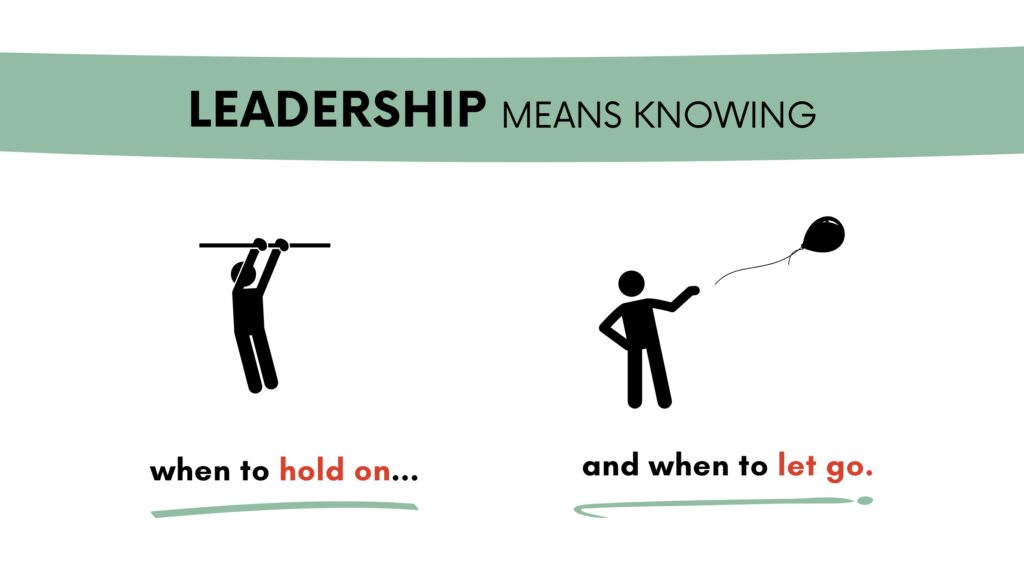I ran a poll on LinkedIn and asked:
“What’s the hardest part about stepping into leadership?”
The top answer didn’t surprise me:
Letting go of hands-on work.
And I hear it all the time from clients:
“I know I need to delegate… but it feels faster if I just do it.”
“I struggle to trust others to do it right.”
“I feel useless when I’m not doing the actual work.”
These aren’t just logistical challenges. They’re mindset blocks—deeply tied to identity, fear, and how we define value.
Why Letting Go Matters
Letting go isn’t just a personal struggle—it’s a leadership must-do. Consider:
- A recent stat from Forbes indicates that leaders who delegate effectively generate up to 33% more revenue than those who don’t.
- According to Gallup, teams are 2.2× more engaged when employees are empowered to take ownership—engagement that drives retention, innovation, and performance.
When leaders try to do it all, they don’t just burn out. They bottleneck growth and employee engagement..
Why Letting Go Feels So Hard
If you’ve built your career on being efficient, reliable, and in control, stepping back doesn’t feel natural. It feels risky. Vulnerable. Even uncomfortable.
Let’s name some of the REAL reasons letting go is hard:
- Perfectionism
“I’d rather do it myself—I know I can get it exactly right.” You’ve got high standards—and you worry others won’t meet them. - Identity Tied to Doing
“I’m afraid I’ll become irrelevant if I stop doing the actual work.” If you’re not producing results, it can feel like you’re not contributing. But leadership is less about doing and more about enabling. - Fear of Risk
“If the team messes it up, it’s on me.” Letting go means allowing room for mistakes—and that can feel threatening when the stakes are high. - Comfort Zone Attachment
“I’ve been doing this for years—it’s proven and certain. Why leave a good thing?” You know you can do the work well. Delegating means entering the unknown. - Worried About Others’ Opinions
“I’ll look weak or incompetent if I admit I need help.” You may fear being seen as lazy or disconnected if you step back—or worse, as not adding value.
These beliefs make it easy to hold on too tightly—even when it’s time to grow.
I remember one of my clients mentioned to me that she got tired of working very long hours making sure her team’s detailed work AND her supervisory work was done. She was stressed out. She agreed that she needed to set boundaries on her time and what she was willing to do. She stopped doing the detailed work and held her team members accountable for their responsibilities. If they didn’t get the work done, she held them responsible, but guided them if they needed it. She told her boss that she was supervising and delegating work, and making sure her team members were stepping up. She felt less stressed and more confident because she stood up for herself. She finally saw that she deserved respect as a manager. She was proud of herself.
Leadership Isn’t About Doing More
Here’s the truth:
Letting go doesn’t mean you care less.
It means you’re ready to lead in a bigger way.
When you hold on to everything, you cap your capacity—and your team’s.
When you let go, you open the door to trust, growth, and expanded impact.Leadership is less about control and more about creating space.
For ideas. For ownership. For people to rise.
Real Example: How Satya Nadella Let Go and Led Better
When Satya Nadella became CEO of Microsoft in 2014, he inherited a culture of control and internal competition.
Instead of trying to micromanage, he let go—of perfectionism, siloed leadership, and doing everything himself. He adopted a “growth mindset” philosophy, empowered key leaders like Scott Guthrie, and trusted his team to take risks and innovate.
The result? Microsoft’s market value grew from $300 billion to over $2 trillion under his leadership.
Letting go didn’t dilute his leadership—it amplified it.
The Mindset Shift: From Control to Growth
Here’s what the shift often looks like:
From “It has to be perfect”
To “Progress and development are more valuable than perfection.”
From “I’m only valuable when I’m doing”
To “My value is in empowering others to do.”
From “I can’t risk failure”
To “I can build resilience and systems to manage risk.”
From “I’m good at this task”
To “I’m here to lead people, not just perform tasks.”
From “What will they think of me?”
To “Leadership requires vulnerability—and courage.”
Take Action: 3 Steps to Start Letting Go Today
- Delegate One Task This Week
Choose something you usually hold onto. Hand it off with clear expectations and reflect after: What went well? What was hard? - Match Tasks to Strengths
Assign a task based on someone’s skill set or growth goals. Say, “I’m assigning this to you because I believe in your strengths.” - Replace Control with Check-Ins
Schedule a quick weekly sync instead of hovering. Ask, “How’s it going? What support do you need?” Empower without micromanaging.
These small shifts build confidence—yours and your team’s.
Leadership is Knowing What to Hold on to – and What to Let Go
This simple truth sits at the heart of powerful leadership:
You hold on to:
✅ Vision
✅ Values
✅ Strategic focus
You let go of:
❌ Over-functioning
❌ Control
❌ Perfectionism
Leadership means knowing when to hold on—and when to let go.
Letting Go Is a Sign You’re Growing
If letting go feels hard, take it as a sign that you’re evolving.
You’re stepping into a new kind of leadership—not just defined by what you do, but by how you think, relate, and develop others.
The next version of your leadership isn’t about pushing harder.
It’s about leading from a new place.
Ready to Shift?
If this resonates, let’s talk.
I offer a free Mindset Breakthrough Call to help you:
- Identify what’s really holding you back from letting go
- Uncover the mindset patterns keeping you in the weeds
- Step into your leadership with more confidence and clarity
Click here to book your free call
You don’t have to lead alone—and you don’t have to keep doing it all.

